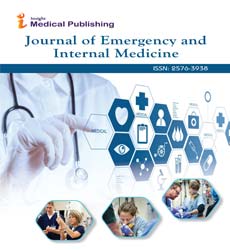ISSN : 2576-3938
Journal of Emergency and Internal Medicine
The Diseases of Warm Climates
Peterhelis Oltla*
Department of Health care, Charisma University of Turks and Caicos Island, UK
- *Corresponding Author:
- Peterhelis Oltla
Department of Health care, Charisma University of Turks and Caicos Island, UK
E-mail: Peterhelisotla@gmail.com
Received Date: December 03,2021; Accepted Date: December 16,2021; Published Date: December 23,2021
Citation: Oltla P (2021) The Diseases of Warm Climates. J Emerg Intern Med Vol.5 No.3
Commentary
Clinical tropical medicine is essential for every modern physician. The diseases of warm climates are no longer restricted by geographic boundaries because the scope and speed of air travel and flows of ideas and people have destroyed the barriers of time and space, and the massive increase in international migration in the past half century makes us all part of a global community. The detection of tropical illnesses is utterly dependent on an awareness of their very existence, and on understanding their pathogenesis, signs, and symptoms. These fundamental facts are rarely taught in any depth in Western medical schools, and the diseases considered in this book the greatest cripplers and killers of the world rate only passing attention in most academic curricula in temperate climates. In some European nations, though, there has been a traditional interest in the diseases of the tropics, an interest developed during the colonial period. In these countries there are still major schools (and hospitals) specializing in tropical medicine. Financial support for these institutions has, however, waned in recent decades as the pressures to treat and investigate domestic ailments steadily escalate. In the United States, an appreciation of tropical medicine has always been far less than in Europe. There are no American schools or hospitals specializing in this discipline, and only a minuscule percentage of our national research budget is allocated to these major albeit neglected diseases. The economic realities of prolonged postgraduate training in the tropics, and the patterns of insurance payments make it difficult to sustain a cadre of experts in tropical medicine. Almost all those whom I have trained, for example, gravitated toward gastroenterology, where colonoscopies and endoscopies are procedures reimbursed at levels far in excess of what is provided to tropicalists. The quality of laboratory diagnosis in developed countries has also fallen over recent decades. For example, the approach of using wet mount analysis to detect intestinal protozoa is an almost lost art; no longer is the characteristic motility of an ameba able to be detected in specimens sent in preservatives to unknown technicians in distant laboratories. A 2010 study in New York City checked known specimens submitted to a major university hospital laboratory and to the largest commercial medical laboratory in the area. The hospital missed 50%, and the commercial diagnostic inaccuracy rate was 70%. Learning tropical medicine should not consist of merely memorizing parasitological and microbiological details. A clinical discipline depends on observations, experience, and judgment. My approach in this text is based on the realization that most medical students wish to become practitioners, and that most graduate physicians want the necessary basic information that will allow them to properly care for patients. In tropical medicine, as in other specialties, clinical tools must be learned and constantly refined. I hope that the excitement, wonder, and satisfaction that I have found in the diagnostic and therapeutic challenges of tropical medicine are reflected in these pages, for that surely is my intention.
Malaria
In the vast under developed areas of the tropics where the majority of the world's population struggle to exist, and which, in this jet age, have become the playgrounds of tourists, the arenas of diplomatic conflicts, and the reservoirs for expanding business cartels malaria rules. No other disease so decimates the childhood population, so enfeebles and destroys adults, or serves so well as a reflection of the public health status of an area. By the end of the first decade of the twenty-first century, international health organizations still reported approximately 250 million cases of malaria and nearly 1 million resulting deaths annually, mostly among children living in Africa. In parts of Africa, the disease of all childhood deaths. Today, malaria is, once again, a major clinical challenge in the temperate climates, as well, because of the enormous increase in travel to malarious areas combined with a failure on the part of tourists to adhere scrupulously to prophylactic antimalarial regimens. There is, at the time of this writing, no effective vaccine against malaria. The present situation represents one of the great disappointments in modern medicine. Malaria remains the great tropical disease. Despite the facts that ancient man recognized swamp fevers (malaria) and that more than a century has passed since Ronald Ross demonstrated the transmission of malaria by the female Anopheles mosquito, the worldwide risk of infection remains. Possibly the most telling example of the present plight is our humbling return to quinine.
Open Access Journals
- Aquaculture & Veterinary Science
- Chemistry & Chemical Sciences
- Clinical Sciences
- Engineering
- General Science
- Genetics & Molecular Biology
- Health Care & Nursing
- Immunology & Microbiology
- Materials Science
- Mathematics & Physics
- Medical Sciences
- Neurology & Psychiatry
- Oncology & Cancer Science
- Pharmaceutical Sciences
